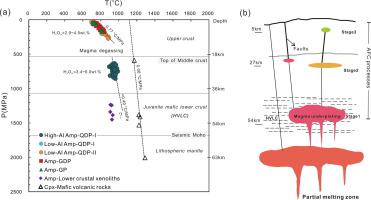当前位置:
X-MOL 学术
›
J. Asian Earth Sci.
›
论文详情
Our official English website, www.x-mol.net, welcomes your feedback! (Note: you will need to create a separate account there.)
Intraplate adakite-like rocks formed by differentiation of mantle-derived mafic magmas: A case study of Eocene intermediate-felsic porphyries in the Machangqing porphyry Cu-Au mining district, SE Tibetan Plateau
Journal of Asian Earth Sciences ( IF 3 ) Pub Date : 2020-07-01 , DOI: 10.1016/j.jseaes.2020.104364 Ying-Jing Wang , Xin-Song Wang , Xian-Wu Bi , Yan Tao , Ting-Guang Lan
Journal of Asian Earth Sciences ( IF 3 ) Pub Date : 2020-07-01 , DOI: 10.1016/j.jseaes.2020.104364 Ying-Jing Wang , Xin-Song Wang , Xian-Wu Bi , Yan Tao , Ting-Guang Lan

|
Abstract Intraplate intermediate-felsic adakite-like rocks are widely considered to be generated via partial melting of the mafic lower crust. However, the genesis of phenocrysts of mafic minerals from some adakite-like rocks suggests that they can originate from mantle-derived magmas through assimilation and fractional crystallization (AFC) processes. In this study, we investigated the petrogenesis of three phases of Eocene porphyries, namely quartz diorite porphyry (QDP-I and QDP-II), granodiorite porphyry (GDP), and granite porphyry (GP), exposed in the Machangqing area of the western Yangtze Craton in the southeastern Tibetan plateau. These porphyries were formed at 34.2–35.2 Ma in an intracontinental extension setting and present adakitic affinities of high Sr/Y (50–95) and La/Yb (50–113) ratios. The similar characteristics of these Machangqing porphyries in terms of whole-rock trace elements and Sr–Nd isotopes, as well as in the mineralogy of amphibole phenocrysts and clinopyroxene antecrysts, indicate that these intermediate-felsic porphyries were derived from the same source. The important observation for investigating the parental magma of these intermediate-felsic porphyries is that they have close temporal and spatial correlations with mantle-derived mafic volcanic rocks. These intermediate-felsic porphyries have slightly enriched Sr–Nd isotopic compositions [(87Sr/86Sr)i = 0.7068–0.7077, eNd(t) = −5.1 to −6.6], affected by limited crustal assimilation, as compared to those of contemporaneous mafic volcanic rocks. The high-Al amphibole phenocrysts and clinopyroxene antecrysts in QDP-I have similar rare earth element (REE) patterns with clinopyroxene phenocrysts in the mafic volcanic rocks, which suggest that these rocks originated from the same mantle-derived mafic magma. In addition, the major elements of these intermediate-felsic and mafic igneous rocks in the Machangqing area show fractional crystallization trends with an increasing magma silica component. Simulations of the major and trace elements of these igneous rocks show that the sequence of fractional crystallization of olivine, clinopyroxene, garnet, amphiboles, biotite, feldspar, and apatite with time promoted the evolution of the magma series. As revealed by the calculated physicochemical conditions during crystallization of the phenocrysts, the initial mafic magmas were derived from depths of greater than 64 km through the partial melting of the metasomatic lithosphere mantle induced by Eocene intraplate extension in the western Yangtze Craton. These initial mafic magmas underwent three stages of fractional crystallization at three levels of the thickened crust: the first at the base of the lower crust (49–55 km); followed by fractional crystallization at the middle crust (24–32 km); and finally at the upper crust (4–5 km). These fractional crystallization processes caused the initial mafic magmas to evolve through the intermediate (roughly represented by QDP-I) to the felsic compositions (GDP and GP). Whole-rock and mineral geochemistry evidence demonstrates that fractional crystallization of mantle-derived magmas, with a small amount of crustal assimilation, generated these Eocene intraplate intermediate-felsic adakitic porphyries in the Machangqing area.
中文翻译:

幔源基性岩浆分异形成的板内类埃达克岩——以青藏高原东南部马长青斑岩铜金矿区始新世中长英质斑岩为例
摘要 板内中长英质埃达克岩被广泛认为是由基性下地壳部分熔融形成的。然而,一些类埃达克岩的镁铁质矿物斑晶的成因表明它们可以通过同化和分步结晶(AFC)过程起源于地幔来源的岩浆。在这项研究中,我们调查了始新世斑岩三个阶段的岩石成因,即石英闪长斑岩(QDP-I 和 QDP-II)、花岗闪长斑岩(GDP)和花岗岩斑岩(GP),出露在西部马场青地区。青藏高原东南部的扬子克拉通。这些斑岩形成于 34.2-35.2 Ma 的大陆内伸展环境中,呈现出高 Sr/Y (50-95) 和 La/Yb (50-113) 比值的埃达克岩亲和性。这些马长青斑岩在全岩微量元素和 Sr-Nd 同位素以及角闪石斑晶和斜辉石前晶的矿物学方面具有相似的特征,表明这些中长英质斑岩来自同一来源。研究这些中长英质斑岩的母岩浆的重要观察结果是它们与地幔衍生的基性火山岩具有密切的时空相关性。这些中长英质斑岩的 Sr-Nd 同位素组成略富集 [(87Sr/86Sr)i = 0.7068-0.7077, eNd(t) = -5.1 至 -6.6],受有限地壳同化的影响,与同时期基性斑岩相比火山岩。QDP-I中的高铝角闪石斑晶和斜辉石前晶与基性火山岩中的斜辉石斑晶具有相似的稀土元素(REE)模式,这表明这些岩石起源于同一地幔衍生的基性岩浆。此外,马长青地区这些中长英质和镁铁质火成岩的主要元素随着岩浆二氧化硅组分的增加呈现分异结晶趋势。对这些火成岩主微量元素的模拟表明,橄榄石、单斜辉石、石榴石、角闪石、黑云母、长石和磷灰石随时间的分异结晶顺序促进了岩浆系列的演化。正如在斑晶结晶过程中计算的物理化学条件所揭示的那样,通过扬子克拉通西部始新世板块内伸展引起的交代岩石圈地幔的部分熔融,最初的基性岩浆来自大于 64 公里的深度。这些初始基性岩浆在增厚地壳的三个层次上经历了三个阶段的分步结晶:第一个在下地壳底部(49-55 公里);随后在中地壳(24-32公里)分步结晶;最后在上地壳(4-5 公里)。这些分步结晶过程导致初始基性岩浆通过中间体(大致由 QDP-I 表示)演化为长英质成分(GDP 和 GP)。全岩和矿物地球化学证据表明,地幔来源的岩浆分次结晶,有少量地壳同化作用,
更新日期:2020-07-01
中文翻译:

幔源基性岩浆分异形成的板内类埃达克岩——以青藏高原东南部马长青斑岩铜金矿区始新世中长英质斑岩为例
摘要 板内中长英质埃达克岩被广泛认为是由基性下地壳部分熔融形成的。然而,一些类埃达克岩的镁铁质矿物斑晶的成因表明它们可以通过同化和分步结晶(AFC)过程起源于地幔来源的岩浆。在这项研究中,我们调查了始新世斑岩三个阶段的岩石成因,即石英闪长斑岩(QDP-I 和 QDP-II)、花岗闪长斑岩(GDP)和花岗岩斑岩(GP),出露在西部马场青地区。青藏高原东南部的扬子克拉通。这些斑岩形成于 34.2-35.2 Ma 的大陆内伸展环境中,呈现出高 Sr/Y (50-95) 和 La/Yb (50-113) 比值的埃达克岩亲和性。这些马长青斑岩在全岩微量元素和 Sr-Nd 同位素以及角闪石斑晶和斜辉石前晶的矿物学方面具有相似的特征,表明这些中长英质斑岩来自同一来源。研究这些中长英质斑岩的母岩浆的重要观察结果是它们与地幔衍生的基性火山岩具有密切的时空相关性。这些中长英质斑岩的 Sr-Nd 同位素组成略富集 [(87Sr/86Sr)i = 0.7068-0.7077, eNd(t) = -5.1 至 -6.6],受有限地壳同化的影响,与同时期基性斑岩相比火山岩。QDP-I中的高铝角闪石斑晶和斜辉石前晶与基性火山岩中的斜辉石斑晶具有相似的稀土元素(REE)模式,这表明这些岩石起源于同一地幔衍生的基性岩浆。此外,马长青地区这些中长英质和镁铁质火成岩的主要元素随着岩浆二氧化硅组分的增加呈现分异结晶趋势。对这些火成岩主微量元素的模拟表明,橄榄石、单斜辉石、石榴石、角闪石、黑云母、长石和磷灰石随时间的分异结晶顺序促进了岩浆系列的演化。正如在斑晶结晶过程中计算的物理化学条件所揭示的那样,通过扬子克拉通西部始新世板块内伸展引起的交代岩石圈地幔的部分熔融,最初的基性岩浆来自大于 64 公里的深度。这些初始基性岩浆在增厚地壳的三个层次上经历了三个阶段的分步结晶:第一个在下地壳底部(49-55 公里);随后在中地壳(24-32公里)分步结晶;最后在上地壳(4-5 公里)。这些分步结晶过程导致初始基性岩浆通过中间体(大致由 QDP-I 表示)演化为长英质成分(GDP 和 GP)。全岩和矿物地球化学证据表明,地幔来源的岩浆分次结晶,有少量地壳同化作用,



























 京公网安备 11010802027423号
京公网安备 11010802027423号